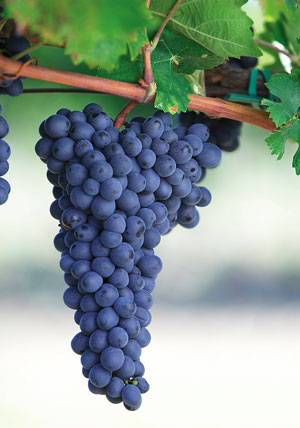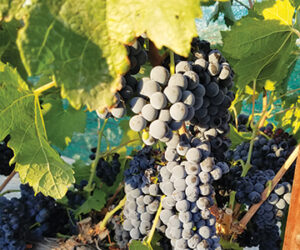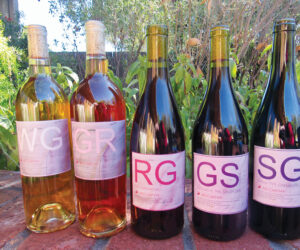 Zinfandel is America’s most popular wine grape: In 1999, some 340,000 tons of Zin was harvested in California alone. The varietal thrives in many other states, from Oregon and Arizona to Illinois, Texas and Tennessee. Zinfandel also can be found in Australia, South Africa, New Zealand, France and Italy. Zinfandel is a winemaker’s dream. It can be made into a wide variety of pleasant styles, from a light-bodied claret to hearty reds, ports and sparkling wine. Since the 1970s, the free-run juice also has been used to make a popular “white” Zinfandel. Zin’s characteristics include pepper, raspberries, blackberries, spice, nuttiness and floral tones. The wide assortment of fruit descriptions includes black currant, strawberry, boysenberry, cranberry, plum, and cherry.
Zinfandel is America’s most popular wine grape: In 1999, some 340,000 tons of Zin was harvested in California alone. The varietal thrives in many other states, from Oregon and Arizona to Illinois, Texas and Tennessee. Zinfandel also can be found in Australia, South Africa, New Zealand, France and Italy. Zinfandel is a winemaker’s dream. It can be made into a wide variety of pleasant styles, from a light-bodied claret to hearty reds, ports and sparkling wine. Since the 1970s, the free-run juice also has been used to make a popular “white” Zinfandel. Zin’s characteristics include pepper, raspberries, blackberries, spice, nuttiness and floral tones. The wide assortment of fruit descriptions includes black currant, strawberry, boysenberry, cranberry, plum, and cherry.
Three Styles of Zin
Because of its versatility, we suggest you consider making three different Zinfandel-based wines from one batch of grapes. Try a white Zinfandel, then a classic red varietal and finally a Zinfandel port. To start, you will need enough ingredients to make 15 gallons (57L) of wine. Then we’ll show you how to make 5 gallons (19L) of white Zinfandel, 5 gallons (19 liter) of hearty red Zinfandel and finally 7 gallons (26L) of port wine. These recipes call for fresh fruit. When it’s time to place your order, look for Zinfandel grapes from the Lodi-Woodbridge area of California. They’ve been earning high marks with many home winemakers.
Ingredients (for three batches)
- 180 to 525 pounds (81-102 kg) fresh Zinfandel grapes
- 60 drops (3 ml) pectic enzyme liquid
- 51 to 60 campden tablets or 4 to 6 teaspoons (17.9 to 37.2g) potassium metabisulfite
- 2 pkgs. (10 g) Red Star Premier Cuvee yeast
- 1 pkg. (5 g) Red Star Cotes des Blancs yeast
- 9 teaspoons (26.4 g) yeast nutrient
- 6 tablespoons (66.6 g) Oak-Mor
- 1 pkg. malolactic culture
- 2 gallons (7.8L) 80-proof brandy
White Zinfandel (five gallons)
- Sanitize all equipment.
- Draw off 5 gallons (19L) of Zinfandel juice, gingerly pressed to minimize skin contact. Place the free-run juice in a 6 or 7 gallon (23.2-27.2 L) glass carboy or a clean, sanitized fermentation container. Save the pressed skin and pulp from this pressing and place in the fermentation container for your red Zinfandel.
- Add 5 crushed campden tablets or 1/2 teaspoon (3.1 g) potassium metabisulfite powder to the juice and let sit for at least four hours.
- Test the acid and sugar and make adjustments if necessary. Acid reading should be in the 0.6 to 0.9 range and Brix reading in the 20° to 23° range.
- Make a yeast starter by pouring 4 ounces (120 ml) of grape juice and 4 ounces (120 ml) of lukewarm water into a bowl then sprinkle in the Red Star Cotes des Blancs yeast and let proliferate for about 30 minutes. Add the yeast starter and 3 teaspoons (8.8 g) of the yeast nutrient to the grape juice and swish to help mix the ingredients.
- Cover the fermentation container, if open at the top, with a plastic cover. If using a glass carboy, insert a rubber bung and fermentation lock (filled with clean water) into the carboy. Fermentation should start within a few days and continue for up to 10 to12 days.
- After several days of fermentation, start to monitor the wine. When specific gravity gets below 1.000, fermentation is complete and you can proceed to the next step. If the specific gravity is above 1.000, allow the wine to continue to ferment until it goes below 1.000.
- Put 5 crushed campden tablets or 1/2 teaspoon (3.1.g) of potassium metabisulfite into a sanitized 5-gallon (19 L) glass carboy. Siphon the wine into the clean carboy and fill up to the bung and fermentation lock. Top up, if necessary, with a neutral white wine or water (if not too much is needed). Leave sediment behind in original fermentation container. Place the carboy in a cool place like a garage or root cellar. This will clear out the tartrate crystals and stabilize the wine. Two or three more rackings will be necessary to finalize the process. At each racking use the campden tablets or potassium metabisulfite to ensure final quality.
- If wine does not clear naturally, use gelatin, kieselsol, or bentonite finings following the manufacturers instructions and allow an additional 3 to 4 weeks for the wine to clear.
- When the wine is clear, it’s time to bottle. If you had to use finings, filter the wine to guarantee complete cleanliness. Taste the wine and adjust for sweetness, then bottle. Note: White Zinfandel usually tastes better when the final sugar count is adjusted to 1 to 2 percent before bottling. After bottling, wait 3 months before drinking.
Red Zinfandel (ten gallons)
Now to make the red Zinfandel. Crush the rest of the Zinfandel grapes and place them into the fermentation container, where you already have the crushed grapes from the white Zinfandel. The additional crushed grapes will help add color and complexity to the wine.
- Make sure that all equipment is properly sanitized.
- Add all of the pectic enzyme liquid into the crushed grapes and juice.
- Add 10 crushed campden tablets or 1 teaspoon (6.2 g) of potassium metabisulfite powder to the juice and crushed grapes. Add the Oak-Mor and let sit overnight.
- The next day, test for acid and sugar and make appropriate adjustments. Acid should be between 0.6 to 0.9 and Brix between 20° and 24°.
- Make a yeast starter by pouring 8 ounces (240 ml) of grape juice and 8 ounces (240 ml) of lukewarm water into a bowl, then add all the yeast nutrient and 2 pkgs. (10 g) Red Star Premier Cuvee yeast. After 30 minutes or so, place all ingredients into the fermentation container and swish around to mix thoroughly.
- Fermentation will start in 2 or 3 days and continue for up to 12 days. The cap (the pulp and the skins) will rise to the top, so twice daily push it down with a sanitized spoon. This allows the color and body to be extracted from the skin and pulp mixture. Between the fourth and sixth day, inoculate the must with the malolactic culture (follow the manufacturer’s instructions).
- Monitor the wine each day with a hydrometer. When the specific gravity reaches 1.000 or lower, it’s time to press out the wine and store it in another container.
- Sanitize two 5-gallon (19 L) carboys. Put 5 crushed campden tablets or 1/2 teaspoon of potassium metabisulfite powder in each carboy. Fill each carboy with the wine and fill to the top. Insert a rubber bung and an air lock into the jug opening.
- Let the wine sit 3 or 4 weeks, then rack again into a clean, sanitized carboy. Three or four more rackings, 4 to 6 weeks apart, should pace the wine to its finish. After the second racking, use 3 crushed Campden tablets (1.4 g) of potassium metabisulfite powder in each new carboy before filling. Leave the sediment in the old carboy.
- The wine should clear itself. If it doesn’t, wait longer and rack until it clears.
- When the wine is clear, it’s time to bottle. Make adjustments, if needed, then bottle 5 gallons of the wine and wait at least 6 months before tasting. Note: Your red Zinfandel table wine should be inky when ready for bottling. The extra grapes (from the white Zinfandel) will add dark color, depth and complexity.
Zinfandel Port (seven gallons)
We now have 5 gallons (19 L) of red Zinfandel wine left in bulk to make our Zinfandel port. Home winemakers have developed creative ways to simplify the process of making port or port-like wines. One popular method is to take a sound red wine, like our Zinfandel, add sugar up to about 8 percent and adjust the alcoholic content, by volume, to about 20 percent. Then you age the mixture (in a charred barrel, if possible) for at least six months. The most difficult part of this method is figuring out the amount of brandy or spirit needed to reach the estimated 20 percent specified. There is a formula — the Pearson Square — that assists winemakers in making this calculation. The formula consists of six steps:
- Draw a square and divide it into thirds vertically and horizontally.
- Place in the upper left-hand corner of the square the alcoholic strength of the brandy (or spirit) to be used in fortification. It is assumed to be 40 percent, or 80 proof.
- In the lower left-hand corner, place the alcoholic strength of the wine that is to be fortified. We assume it is 12 percent.
- In the center of the square, place the desired alcoholic strength of the finished product. It is assumed that this is to be 20 percent.
- Subtract the center figure from the figure in the upper left-hand corner, and place the remainder in the lower right-hand corner (40-20=20)
- Subtract the figure in the lower left-hand corner from the figure in the center of the square and place the remainder in the upper right-hand corner (20-12=8). The last figure (8) is the number of parts of the 80 proof (40 percent alcohol) brandy (or spirit) needed to fortify 20 parts of wine of the indicated alcohol strength up to 20 percent of alcohol. Or 2 gallons (7.6L) of 80 proof brandy should be added to 5 gallons (19L) of 12% wine to bring it up to 20% alcohol. Final total equals 7 gallons (26.6L) of Port-type Zinfandel wine. Age for at least six months in a charred barrel, if possible, or in a carboy.





